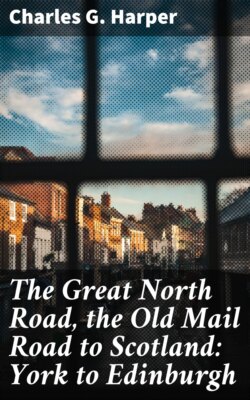Читать книгу The Great North Road, the Old Mail Road to Scotland: York to Edinburgh - Charles G. Harper - Страница 4
На сайте Литреса книга снята с продажи.
II
ОглавлениеTable of Contents
The grim blackened walls of York Castle confront the traveller who approaches the city by Fishergate, and lend a gloomy air to the entrance; the more gloomy because those heavy piles of sooty masonry nowadays encircle a prison for malefactors, rather than forming the defences of a garrison, and keep our social enemies within, instead of a more chivalric foe without. For over two hundred years York Castle has been an assize court and a gaol, and the military element no longer lends it pure romance. Romance of the sordid kind it has, this beetle-browed place of vain regrets and expiated crimes, of dismal cells and clanking fetters; but if you would win back to the days of military glory which once distinguished it, your imaginary journey will be lengthy indeed. These battlemented walls, enclosing four acres of ground, and with a compass of over eleven hundred yards, were completed in 1856, and, with the prison arrangements within, cost £200,000. If, as the poet remarks, “peace hath her victories, no less renowned than war,” she also needs defences, as much against the villainous centre-bit as against the foreign foe.
But there is still something left of the York Castle of old, although you must win to it past frowning portals eloquent of a thousand crimes, great and small, guarded by prison warders and decorated with notice-boards of Prison Regulations. Clifford’s Tower, this ancient portion, itself goes no farther back into history than the time of Edward the First; and of the buildings that witnessed the appalling massacre of the Jews, in March 1190, nothing fortunately remains. It cannot be to the advantage of sightseers that the blood-stained stones of that awful time should stand. History alone, without the aid of sword or shattered wall, is more than sufficient to keep the barbarous tale alive, of how some five hundred Jews of all ages and sexes fled for protection to the Castle keep, and were besieged there for days by Christians, thirsting for their blood. Their death was sure: only the manner of it remained uncertain. The wholesale slaughter of Jews at Lynn, Lincoln, and Stamford rendered surrender impossible, and rather than die slowly in the agonies of starvation they set the Castle on fire, husbands and brothers slaying the women and children, and then stabbing themselves. Those few who feared to die thus opened the gates as morning dawned. “Affliction has taught us wisdom,” they said, “and we long for baptism and for the faith and peace of Christ”; but even as they said it the swords and axes of ruthless assassins struck them down. Christ was avenged, and, incidentally, many a Christian debtor cried quits with his Jewish creditor as he dashed out the infidel’s brains. It is not often given to champions of causes, religious or political, to make one blow serve both public and private ends, and those Christians were fortunate. At the same time, sympathy with the murdered Jews may easily be overstrained. They had but sown the wind and reaped the whirlwind. Trading and following the traditional Jewish occupation of usury, they had eaten like a canker into the heart of York. They had lived in princely style, and knew how to grind the faces of their Christian debtors, whose lives they had made miserable, and so simply fell victims to that revenge which has been aptly described as “a kind of wild justice.”
Clifford’s Tower, standing where these scenes were enacted, is a roofless shell, standing isolated on its mound within the Castle walls, and obtains its name, not from its builder, but from Francis Clifford, Earl of Cumberland, who made a doorway in it in the time of Charles the First. It was ruined by explosion and fire in 1684, and so remains, shattered and overgrown with trees and grass, a picturesque object that the eye loves to linger upon in contrast with the classic buildings that occupy the old Castle wards, and speak of crime and its penalties. He who would bring back the crimes and ferocities of a hundred and fifty years or more to the mind’s eye can have his taste gratified and the most vivid pictures conjured up at the sight of such choice and thrilling relics as the horn-handled knife and fork with which the bodies of rebels captured in the ’45 were quartered; the leathern strap that Holroyd used for the purpose of hanging his father from the boughs of a cherry-tree; a fragment of the skull of Eugene Aram’s victim, Daniel Clark; the curiously varied implements used by wives and husbands who murdered their yoke-fellows, ranging from the unwifely sledge-hammer and razor wielded by wives, to the knives and pokers chiefly affected by the husbands; Jonathan Martin the incendiary’s impromptu flint and steel, and the bell rope by whose aid he escaped from the Minster; and those prime curiosities, Dick Turpin’s fetters. Even Turpin’s cell can be seen by those who, after much diligent application to the Prisons Department of the Home Office, procure the entrée to the Castle; and in that “stone jug,” as the criminals of old called their cells, the imaginative can reconstruct their Turpin as they will. Many a better man than he has occupied this gloomy dungeon, but scarce a worse.
